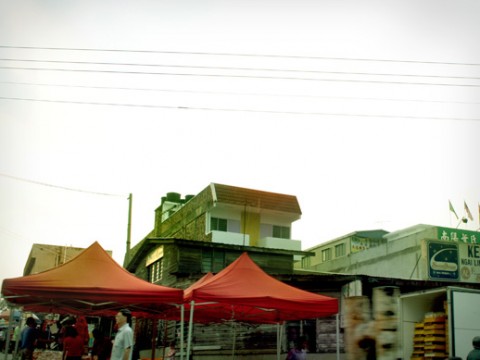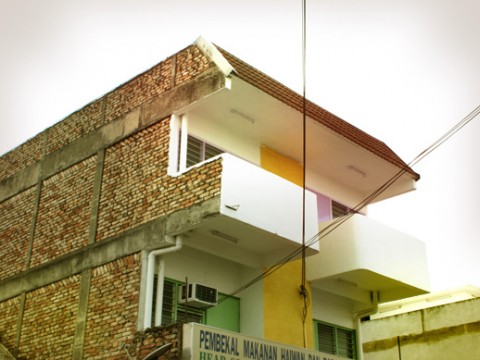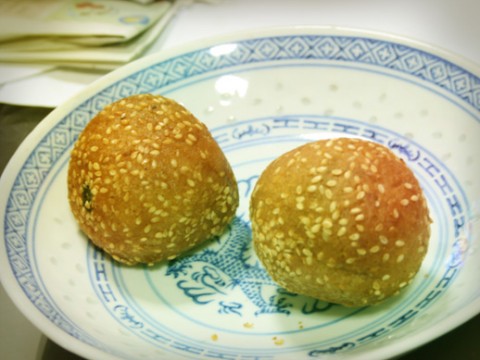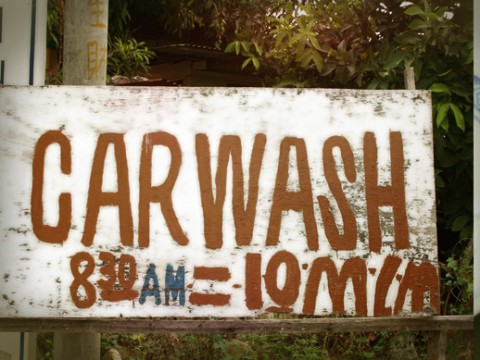

It was all very scattered and uncertain but the good intentions were there from the beginning. Artist Chu Yuan sent me an e-mail asking me to get involve in Entry Points, the inaugural 1948 Artspace project in Serdang.

She brought me to the space, which was located beside the Democratic Action Party’s (DAP) office. It was rustic and a little obscure. Thoughts had flashed through my mind, envisioning the potential of this space and how could it be utilised for different projects. I was also excited partly due to the context: displaying contemporary art in Serdang for the obstinate elders? I started imagining us drawing blanks from those disinterested faces, cynical with the almost expected impassivity, and possibly sniggering at us in unpleasant colloquial Hakka.
So be it, I say. Though such snarky response never came, and neither did the predetermined ideals borne in the call for entries nor the purported interactivity – as its title suggested – resulted in artistic or cultural awareness within the community. Throughout the entire period of the exhibition, the excitement of community engagement mellowed down after the opening event, partially due to the lack of human resources. Few weeks after the Entry Points programme, the space was reclaimed by the owner who wanted to put it into better use – i.e. to start his own business. 1948 Artspace thus functions without a physical space today.

It started and ended abruptly, the vision and objective of setting up a space in Serdang has not met. But let’s view this situation from another point of view, the now spaceless 1948 Project can become more mobile, no longer bound to any specific location, operating on a much more spontaneous level.
It is only a beginning. After all, 1948 Artspace did stir up something. Be that the gathering during the opening, the community greetings and introduction meetings, eating cakes and Jin Deuis, chit-chatting about anything other than the works on display. Aren’t these “entry points” too?

I am happy with that experience of making art about Serdang. It has never come across my mind before this. The Entry Points, despite written as an introduction of contemporary art to the local community, has a more profound impact on me. I started to observe this place and intriguingly found many vernacular aesthetic that I have only notice of late. These seem like treasures to me now, even as some people continue to doubt my sanity whenever I stare at the decorated altars, the Oriental grille patterns or the wobbly hand painted sign spelling out – ‘Car Wash’.

If art is everywhere around Serdang, do we really need an art space? It seems like Serdang itself is a big gallery where the “artworks” are concealed only by our own insensitivity. Today I find myself writing about this town, seeing it as a whole new place, deciphering the socio-political landscape of its oppresive history in its ruggedness, meagerness and reticence – wanting to know the psychological make-ups that shaped the aesthetics of the Serdang where I now live.
~
Tan Zi Hao is currently completing his studies at a local university. Working primarily with the community in Serdang (known presently as Seri Kembangan), he runs a young people’s drama collective Logamaya (http://aoa-logamaya.blogspot.com/) and a children art education project Projek Semai (http://projeksemai.blogspot.com/).
Sorry, the comment form is closed at this time.
Though 1948 Artspace functions without a physical space, we can still organise some event or function that related with Serdang’s culture such as traditional food of Hakka as you said, and also some traditional business that recall the “Serdangist” memory. Maybe we should focus on our event language possibly using Hakka and Cantonese as lot of them can’t understand English so well. I am strongly believe that will be more efficient.
‘It seems like Serdang itself is a big gallery where the “artworks” are concealed only by our own insensitivity.’
I agree with you completely. With our mind and our eyes alone, art can atleast be found, if not made.
A dominant point of view in our local scene is that art is an object, a piece of possession, whose quality is tied closely to famous personalities and specially constructed settings. Duchamp has already made this artificiality clear with a simple urinal in 1917 but did we really appreciate its ramifications? When we say art is anything, many react like animals who were imprisoned for so long that they do not know how to, or do not want to pass through a cage that has been open free for them to explore. Nonetheless, one must admit that a peacock remains beautiful even if it is sealed inside a glass prison.
If art is understood as a state of flux that flows in pace with life and time, being able to shift our perspective may be one of the better ways of capturing or recapturing it in a more authentic or powerful form. Hmmm, I can imagine you smiling at the sight of these curiousities of the mundane, as though you saw throught your mental glasses a free range invisible kampung chicken running through the streets of Serdang.
Well, I must say thought that I much prefer my ‘tukar tiub’ sign in Taman Desa over your uppity Serdang ‘carwash’ anytime.
‘introduction of contemporary art to the local community’
Si Zi Hao,
Baik kau sedar awal-awal ni, ada yg sangkut bawah tempurung tak keluar-keluar.
Sampai bila artis akan sedar kalau buat proyek komuniti, diapa harus mula dari kehendak komuniti.
Kalau tidak, lepas KENDURI perlancaran, sejuk semua, hangat-hangat tahi ayam. Salah pula orang kampung, tak faham seni .
Tanyalah diri, proyek ‘Memperkenalkan Seni Kontemporer’ itu untuk keperluan siapa, untuk kembangkan biodata artis atau kehendak komuniti. Adakah orang kat komuniti tu dijadi penasihat untuk proyek atau berbicara dengan mereka?
Lain kali, buat lah proyek ‘Memperkenalkan Keperluan Komuniti utk Artis’ sebelum mereka nak rancang projek ‘Memperkenalkan Seni Kontemporer utk Komuniti’.
Atau, lupa seni aja, buatlah KENDURI besar-besaran masakan Hakka tradisi. Biar orang kampung enjoy. Kan dah banyak artis masak tomyam, buat popiah, kasi aiskrim and hidang kopi sebagai seni : )
Hi Zi Hao,
Thanks for putting Serdang and Entry Points on the Arteri map! Few points I would like to respond to here. Firstly, you write that Entry Points was “written as an introduction of contemporary art to the local community”…well, that’s not the intention actually.
Entry Points tried to initiate a 2-way communication between the artists and residents of Seri Kembangan (current name for Serdang) – “entry points” as signifying a door where there are 2 way flows/ movements – FIRSTLY for the artists to enter into, learn about and from the ‘community’ and the spaces of the ‘community’ (I had actually used the term ‘residents’ rather than ‘community’ and I’ll elaborate on this later); and secondly for the residents to be able to enter into engagement with art, artists and the spaces of art, even then I asked the artists to consider how they can provide some further entry points for the viewers to be able to engage with the art – NOT just by display, but find other ways to expand the engagement, although many artists found this difficult. Well, Entry Points was just a starting point of engagement, and I see it very positively, it has provided much to think about and to build on.
Secondly, you write: “Though such snarky response never came, neither did the predetermined ideals borne in the call for entries nor the purported interactivity – as its title suggested – resulted in artistic or cultural awareness within the community.” Hmm… predetermined ideals… were there any? Certainly not from my part – in terms of what results to expect from the project or the kinds of responses to it, and I think it’s important not to have any actually. But, we are a bunch of fairly diversified artists in the project, invited primarily based on fact that each is either living or working in and around SK (or have done work on new villages) and apart from conversations and discussions where I tried to discuss process and approaches, I chose not to interfere too much, believing that each have to find his/her own way around finding these entry points for engagement, so it is natural that each of us would have formed different ideas around the project. And, I did get residents asking me the space and further activities after the project and one is very sorry that the space is now gone :-( however, the projects will continue!!
The ‘community’ in Serdang is diversified, fragmented and fluid, as with any community, in different degrees. Nowadays, a ‘community’ defined by location is not ONE cohesive knowable entity – there are many separate groups, networks and ‘communities’ within a so-called physical community. So, certainly to do “community” art is extremely difficult, and I would hesitate to call Entry Points a ‘community art’ project, and many artists who have realised the difficulty of working with ‘community’ have begun rethinking about their work as ‘participative’ art, or ‘locally engaged art’ or use a concept like ‘context-responsive’ or projects to develop ‘sense of place’, choosing to focus on particular aspects of a previously more expansive practice. However, it is easier to make people understand if you use a term like ‘community’. I intended Entry Points to be a beginning of a long term engagement, which is why I chose to work with artists from around SK. FetishKenduri has asked, “did we ask the community what they needed?” this is one approach that some community artists, including myself have tried out, and we also found out that it deos not work in the long term, becoz it cannot sustain the relationship lah – either way of the artist just making art in their own concept and putting it for show in the ‘community’s’ spaces, or the artists doing work for or on behalf of the community, i.e. placing themselves at the service of the ‘community’, does not sustain the relationship. In the first the residents get tired/ disinterested of the ‘art’, and in the later cases, the artists get tired and feel no longer inspired/ demoralised. Which is some artists have been looking for alternatives to these 2 ways of working – for example, to find the common ground, the common area of interest, where the artist’s and the residents/ members of the ‘community’s’ interest can be activated and sustained, and to develop 2-way relationships of learning. It should be a 2-way relationship, in which the artists dialogue and learn from the residents and the residents also learn from the artists, becoz each group have some specialised knowledge and skills that the other does not have. We had a good discussion about this during and after the forum held within Kung Yu’s Cadangan2 exhibition at Galleri Petronas. In theory it’s much simpler than practice – this is extremely difficult, like matching making for marriage u know — have to put in a lot of time and effort to get it right! And I can see that your journey has begun… here’s to more cakes, tea, jindui and chit chat!!